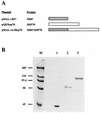Characterization of the immunostimulatory properties of Leishmania infantum HSP70 by fusion to the Escherichia coli maltose-binding protein in normal and nu/nu BALB/c mice
- PMID: 9423878
- PMCID: PMC107897
- DOI: 10.1128/IAI.66.1.347-352.1998
Characterization of the immunostimulatory properties of Leishmania infantum HSP70 by fusion to the Escherichia coli maltose-binding protein in normal and nu/nu BALB/c mice
Abstract
Leishmania infantum HSP70 has been described as an immunodominant antigen in both humans and dogs suffering from visceral leishmaniasis. In this study, we used L. infantum HSP70 fused to Escherichia coli maltose-binding protein (MBP), as the reporter protein, to analyze the influence of HSP70 on the immunogenicity of MBP in BALB/c mice. Plasmids were constructed to produce the three recombinant proteins used in this study, namely, MBP, L. infantum HSP70, and MBP-HSP70, which consists of MBP fused to the L. infantum HSP70 amino terminus. Immunization of BALB/c mice with the MBP-HSP70 fusion protein elicited humoral and cellular responses against MBP that were higher by an order of magnitude than those elicited by immunization with MBP alone or with a mixture of MBP and HSP70. Covalent linkage of MBP to HSP70 was essential for eliciting a strong anti-MBP immune response. Cytokine secretion and immunoglobulin G isotype analyses indicated that immunization with the MBP-HSP70 fusion protein preferentially induces a Th1 immune response. Immunization of athymic nu/nu mice with the MBP-HSP70 fusion protein unexpectedly gave rise to an anti-MBP humoral response showing features of a T-cell-dependent response. Thus, we present evidence that L. infantum HSP70 demonstrates an adjuvant effect in the immune response against a covalently linked reporter protein.
Figures




Similar articles
-
Immunostimulatory properties of the Leishmania infantum heat shock proteins HSP70 and HSP83.Mol Immunol. 1999 Dec;36(17):1131-9. doi: 10.1016/s0161-5890(99)00136-4. Mol Immunol. 1999. PMID: 10698315
-
Analysis of the adjuvant effect of recombinant Leishmania infantum Hsp83 protein as a tool for vaccination.Immunol Lett. 2001 Mar 1;76(2):107-10. doi: 10.1016/s0165-2478(01)00179-1. Immunol Lett. 2001. PMID: 11274727
-
Evaluation of antibody responses elicited by immunization of mice with a pneumococcal antigen genetically fused to murine HSP70 and murine interleukin-4.Acta Biochim Biophys Sin (Shanghai). 2006 Feb;38(2):129-35. doi: 10.1111/j.1745-7270.2006.00133.x. Acta Biochim Biophys Sin (Shanghai). 2006. PMID: 16474904
-
The heat shock proteins, Hsp70 and Hsp83, of Leishmania infantum are mitogens for mouse B cells.Cell Stress Chaperones. 2002 Oct;7(4):339-46. doi: 10.1379/1466-1268(2002)007<0339:thspha>2.0.co;2. Cell Stress Chaperones. 2002. PMID: 12653478 Free PMC article.
-
Use of plasmids for expression of proteins from the genus Leishmania in Escherichia coli: current state and perspectives.Appl Microbiol Biotechnol. 2020 May;104(10):4273-4280. doi: 10.1007/s00253-020-10548-5. Epub 2020 Mar 25. Appl Microbiol Biotechnol. 2020. PMID: 32215706 Review.
Cited by
-
Mycobacterium hsp65 DNA entrapped into TDM-loaded PLGA microspheres induces protection in mice against Leishmania (Leishmania) major infection.Parasitol Res. 2006 May;98(6):568-75. doi: 10.1007/s00436-005-0088-5. Epub 2006 Jan 24. Parasitol Res. 2006. PMID: 16432754
-
Glycoinositolphospholipids from Trypanosoma cruzi induce B cell hyper-responsiveness in vivo.Glycoconj J. 2000 Oct;17(10):727-34. doi: 10.1023/a:1011082925179. Glycoconj J. 2000. PMID: 11425193
-
A role of carboxy-terminal region of Toxoplasma gondii-heat shock protein 70 in enhancement of T. gondii infection in mice.Korean J Parasitol. 2000 Jun;38(2):107-10. doi: 10.3347/kjp.2000.38.2.107. Korean J Parasitol. 2000. PMID: 10905074 Free PMC article.
-
Potential role for Toll-like receptor 4 in mediating Escherichia coli maltose-binding protein activation of dendritic cells.Infect Immun. 2007 Mar;75(3):1359-63. doi: 10.1128/IAI.00486-06. Epub 2007 Jan 12. Infect Immun. 2007. PMID: 17220311 Free PMC article.
-
DNA immunization with the gene encoding P4 nuclease of Leishmania amazonensis protects mice against cutaneous Leishmaniasis.Infect Immun. 2003 Nov;71(11):6270-8. doi: 10.1128/IAI.71.11.6270-6278.2003. Infect Immun. 2003. PMID: 14573646 Free PMC article.
References
-
- Barrios C, Lussow A R, Van Embden J, Van der Zee R, Rappuoli R, Costantino P, Louis J A, Lambert P-H, Del Giudice G. Mycobacterial heat-shock proteins as carrier molecules. II. The use of the 70 kDa mycobacterial heat shock protein as carrier molecules. II. The use of the 70 kDa mycobacterial heat shock protein as carrier for conjugated vaccines can circumvent the need for adjuvants and Bacillus Calmette Guérin priming. Eur J Immunol. 1992;22:1365–1372. - PubMed
-
- Behr C, Sarthou J-L, Rogier C, Trape J-F, Dat M H Q, Michel J-C, Aribot G, Dieye A, Claverie J-M, Druihle P, Dubois P. Antibodies and reactive T cells against the malaria heat-shock protein Pf72/hsp70-1 and derived peptides in individuals continuously exposed to Plasmodium falciparum. J Immunol. 1992;149:3321–3330. - PubMed
Publication types
MeSH terms
Substances
LinkOut - more resources
Full Text Sources
Other Literature Sources
Molecular Biology Databases
Research Materials
Miscellaneous

